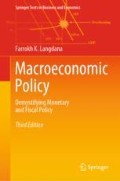Abstract
This foundation chapter begins with definitions of key macrovariables and policy instruments essential to macroeconomic policy analysis.
Notes
- 1.
The exact mechanism by which money growth is changed will be covered in detail in Chap. 11.
- 2.
The Great Stagflation is discussed in the context of the “second paradigm shift” in Chap. 10. The US macroeconomic responses following 9/11 and the sub-prime crisis are also included and analyzed in later chapters.
- 3.
A “model” is simply a well-articulated, theoretical macroeconomic framework. Typically a model includes descriptions (equations) of the goods, money, foreign exchange and labor markets. These markets can be represented and analyzed graphically or mathematically. The major focus of this volume will be on graphical analysis emphasizing the real-world policy aspects of macroeconomics.
- 4.
The discussion of the time-series generated Identification Problem in Chap. 10 explains how two very different models with drastically different policy prescriptions can legitimately co-exist and explain macroeconomic behavior equally well.
- 5.
For example, the boost in GDP obtained by harvesting every tree in the vast forests of the Pacific Northwest in the US would certainly be dwarfed by the ecological disaster that would follow. In fact, historically, economies experiencing phenomenal GDP growth have often also experienced accompanying increases in pollution; Dickensian England is an oft-cited example.
- 6.
The eight categories along with their general expenditure proportions are housing (43 %), food and beverages (15 %), transportation (17 %), medical care (7 %), entertainment (6 %), education and communication (6 %), apparel and upkeep (4 %), and other (about 2 %).
- 7.
Named after Stanford University Professor, Michael Boskin, chairman of the committee. While it was clear for some time that the CPI was overstating actual inflation, the Boskin commission systematically estimated this value.
- 8.
The G7 economies are Canada, France, Germany, Italy, Japan, the UK, and the US. With Russia included, we have the G8.
Author information
Authors and Affiliations
Corresponding author
Rights and permissions
Copyright information
© 2016 Springer International Publishing Switzerland
About this chapter
Cite this chapter
Langdana, F.K. (2016). National Income Accounts. In: Macroeconomic Policy. Springer Texts in Business and Economics. Springer, Cham. https://doi.org/10.1007/978-3-319-32854-6_2
Download citation
DOI: https://doi.org/10.1007/978-3-319-32854-6_2
Published:
Publisher Name: Springer, Cham
Print ISBN: 978-3-319-32852-2
Online ISBN: 978-3-319-32854-6
eBook Packages: Economics and FinanceEconomics and Finance (R0)

